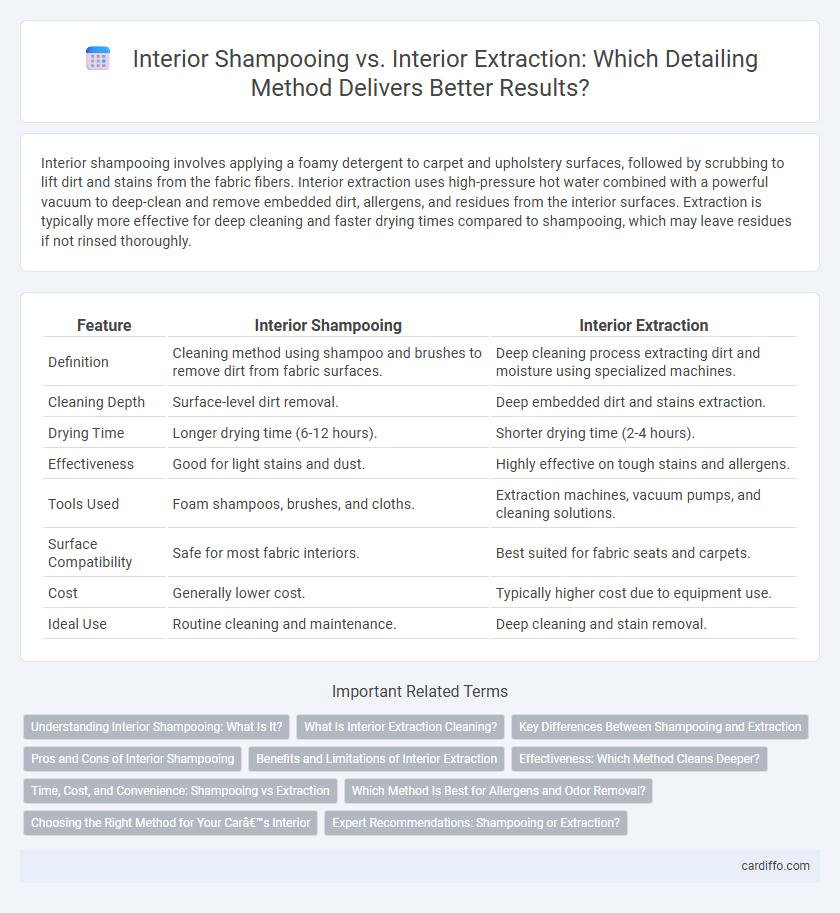Interior shampooing involves applying a foamy detergent to carpet and upholstery surfaces, followed by scrubbing to lift dirt and stains from the fabric fibers. Interior extraction uses high-pressure hot water combined with a powerful vacuum to deep-clean and remove embedded dirt, allergens, and residues from the interior surfaces. Extraction is typically more effective for deep cleaning and faster drying times compared to shampooing, which may leave residues if not rinsed thoroughly.
Table of Comparison
| Feature | Interior Shampooing | Interior Extraction |
|---|---|---|
| Definition | Cleaning method using shampoo and brushes to remove dirt from fabric surfaces. | Deep cleaning process extracting dirt and moisture using specialized machines. |
| Cleaning Depth | Surface-level dirt removal. | Deep embedded dirt and stains extraction. |
| Drying Time | Longer drying time (6-12 hours). | Shorter drying time (2-4 hours). |
| Effectiveness | Good for light stains and dust. | Highly effective on tough stains and allergens. |
| Tools Used | Foam shampoos, brushes, and cloths. | Extraction machines, vacuum pumps, and cleaning solutions. |
| Surface Compatibility | Safe for most fabric interiors. | Best suited for fabric seats and carpets. |
| Cost | Generally lower cost. | Typically higher cost due to equipment use. |
| Ideal Use | Routine cleaning and maintenance. | Deep cleaning and stain removal. |
Understanding Interior Shampooing: What Is It?
Interior shampooing involves applying a specialized foaming cleaner to fabric surfaces inside a vehicle, such as seats and carpets, to break down dirt, stains, and odors. This process uses a microfiber brush or machine to agitate the fibers, ensuring deep cleaning and removal of embedded contaminants. Unlike interior extraction, which involves wet vacuuming out loosened debris and moisture, shampooing primarily focuses on surface cleaning with controlled moisture application.
What Is Interior Extraction Cleaning?
Interior extraction cleaning involves using specialized machines that spray a cleaning solution deep into upholstery or carpet fibers and then extract dirt, grime, and moisture simultaneously. This method effectively removes embedded contaminants, allergens, and stains that surface cleaning cannot reach, enhancing overall interior hygiene and appearance. Interior extraction is especially beneficial for fabric seats, carpets, and floor mats, providing a thorough and comprehensive clean.
Key Differences Between Shampooing and Extraction
Interior shampooing involves applying a foaming cleaner to fabric surfaces, agitating dirt and stains before wiping away residues, making it effective for surface-level grime. Interior extraction uses a powerful hot water extraction machine to inject cleaning solution deep into upholstery fibers and immediately vacuum it out, removing embedded dirt and allergens. The key differences lie in shampooing's surface cleaning versus extraction's deep fiber penetration, with extraction providing a more thorough and lasting interior cleaning.
Pros and Cons of Interior Shampooing
Interior shampooing effectively removes dirt, stains, and odors from fabric upholstery, providing a deep clean that revitalizes the vehicle's interior. However, it often requires longer drying times and may leave residue if not rinsed properly, potentially attracting more dirt. This method is generally more affordable and accessible than interior extraction but may be less effective on heavily soiled or molded surfaces.
Benefits and Limitations of Interior Extraction
Interior extraction offers deep cleaning by using powerful suction to remove embedded dirt, dust, and allergens from upholstery and carpets, enhancing air quality and prolonging fabric life. It effectively reaches beneath surfaces compared to surface-only methods like interior shampooing, which may leave residues causing rapid re-soiling. However, interior extraction requires specialized equipment, can be time-consuming, and may lead to prolonged drying times, increasing the risk of mold or mildew if not properly managed.
Effectiveness: Which Method Cleans Deeper?
Interior extraction removes dirt and contaminants embedded deep within upholstery fibers using powerful suction, achieving a more thorough clean compared to interior shampooing. Interior shampooing relies on detergent application and scrubbing, which can loosen surface grime but often leaves residues trapped deeper inside. For maximum effectiveness in deep cleaning vehicle interiors, extraction is the preferred method due to its ability to extract moisture and debris from beneath the fabric surface.
Time, Cost, and Convenience: Shampooing vs Extraction
Interior shampooing typically requires less time and lower cost compared to interior extraction, making it a more convenient option for routine car detailing. Shampooing involves scrubbing fabric surfaces with detergent and water, which dries faster but may not remove deep-set dirt as effectively as extraction. Interior extraction involves using specialized equipment to inject and extract cleaning solutions deeply, offering a thorough clean but usually at a higher price point and longer service time.
Which Method Is Best for Allergens and Odor Removal?
Interior extraction is superior for allergen and odor removal as it uses powerful suction combined with cleaning solutions to deeply remove dirt, dust mites, and pet dander embedded in upholstery and carpets. Interior shampooing, while effective at surface cleaning through foaming agents and scrubbing, often leaves residues that can attract more allergens over time. Extraction's ability to thoroughly cleanse and extract moisture ensures a healthier, fresher interior environment for allergy sufferers.
Choosing the Right Method for Your Car’s Interior
Interior shampooing deeply cleans fabric surfaces by agitating and lifting embedded dirt, ideal for heavily soiled upholstery and carpets. Interior extraction uses high-powered suction combined with cleaning solutions to remove dirt and moisture, making it perfect for quick drying and maintaining delicate materials. Selecting the right method depends on fabric type, soil level, and drying time preferences to ensure optimal interior care.
Expert Recommendations: Shampooing or Extraction?
Expert recommendations emphasize interior extraction over shampooing for deep cleaning vehicle upholstery due to its effectiveness in removing embedded dirt and allergens. Extraction uses high-pressure water and vacuum suction, ensuring thorough dirt and moisture removal, which prevents mold and prolongs fabric life. Shampooing may refresh surface appearance but often leaves residues that attract dirt, making extraction the preferred method for long-lasting interior cleanliness.
Interior Shampooing vs Interior Extraction Infographic

 cardiffo.com
cardiffo.com